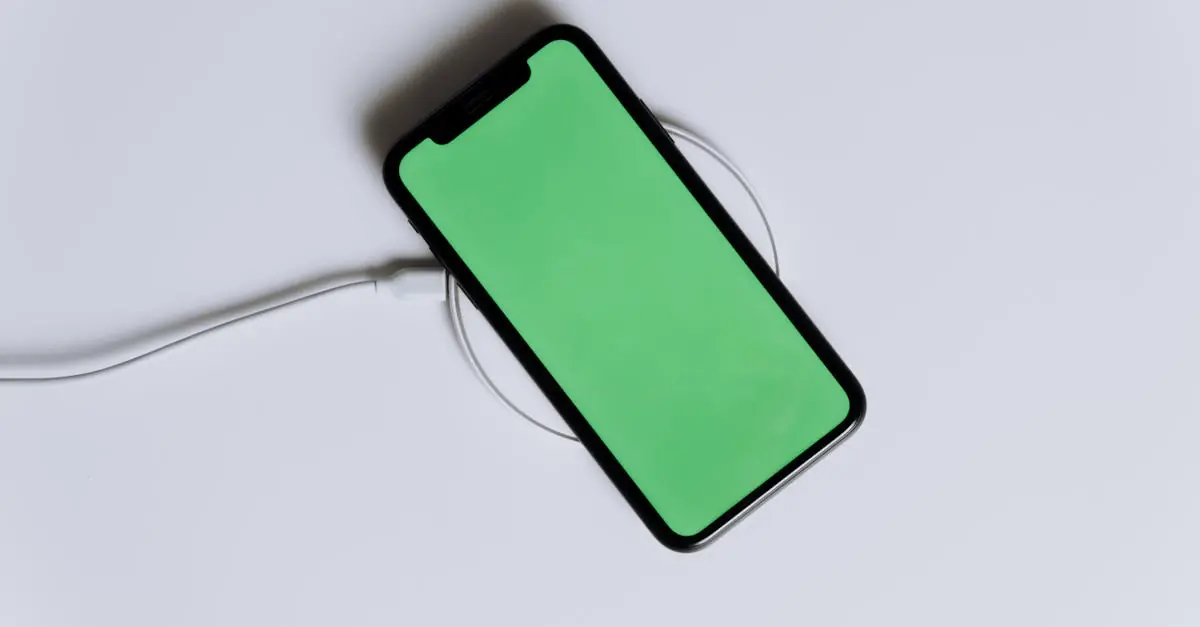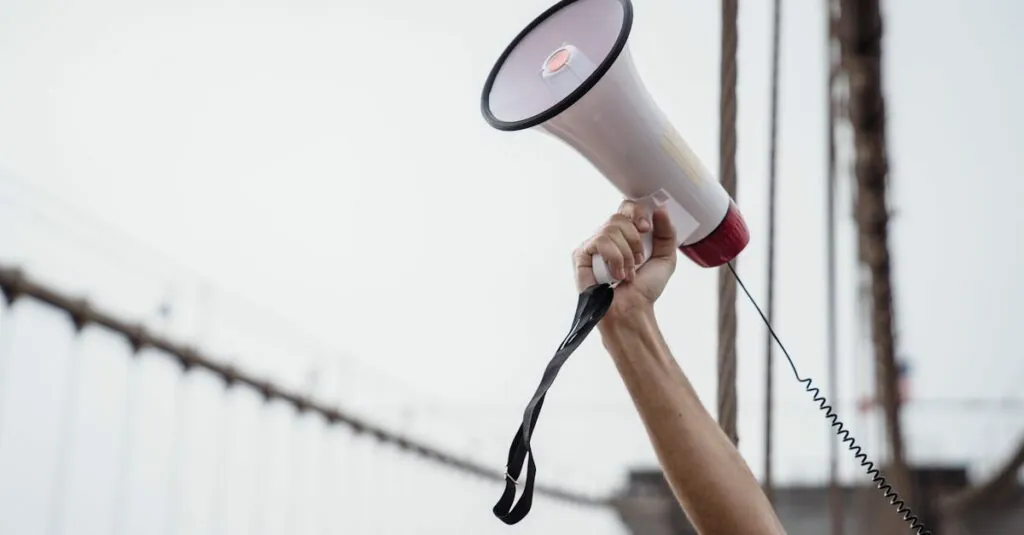Table of Contents
ToggleImagine this: you’re out and about, enjoying life, when suddenly your friend’s phone gasps for battery like a fish out of water. Panic sets in. But wait! What if your trusty iPhone 13 could swoop in like a superhero, saving the day with a quick charge?
While the iPhone 13 boasts impressive features, the ability to charge another phone isn’t one of them. However, that doesn’t mean you can’t explore clever alternatives. In a world where sharing is caring, understanding the charging capabilities of your devices can be a game-changer. So, let’s dive into the details and find out how your iPhone 13 can still play a vital role in keeping those devices alive and kicking.
Overview of iPhone 13 Charging Features
The iPhone 13 offers a variety of charging features, although it lacks the ability to charge other phones. Users should understand these functionalities to maximize their device’s performance.
Wireless Charging Capabilities
The iPhone 13 supports MagSafe and Qi wireless charging standards. MagSafe technology enables faster wireless charging with compatible accessories, reaching up to 15 watts. Qi wireless charging works with numerous third-party chargers, delivering up to 7.5 watts. Users find convenience in the magnetic alignment of MagSafe, ensuring efficient charging without cumbersome cords. The device also retains compatibility with older wireless chargers, making it versatile in various environments.
Reverse Wireless Charging Potential
The iPhone 13 does not support reverse wireless charging. Other smartphones, including select models from competitors, offer this feature, allowing them to charge additional devices. Instead, iPhone 13 users must rely on traditional power banks or chargers for sharing power. Awareness of this limitation is essential for users who consider charging accessories like AirPods or Apple Watch. While the iPhone 13 excels in other charging aspects, reverse wireless charging remains absent from its features.
Understanding Reverse Wireless Charging
Reverse wireless charging allows one device to transfer its battery power to another device wirelessly. While this feature offers convenience for users with compatible devices, the iPhone 13 does not support it.
How Reverse Wireless Charging Works
Reverse wireless charging utilizes the Qi standard to transfer power using electromagnetic fields. A phone equipped with this feature can share its battery with smaller devices like earbuds or smartwatches. The process starts when an initiating device, often a smartphone, creates a magnetic field. When a compatible device is placed against it, energy transfers efficiently. This technology enhances user experience by allowing seamless power sharing without cables.
Benefits of Reverse Wireless Charging
Reverse wireless charging provides several advantages. Users can charge multiple devices conveniently without needing additional cables. This feature allows for on-the-go charging, making it valuable during travel or long days out. It also supports charging among various devices, such as smartphones, earbuds, and smartwatches, promoting compatibility. Sharing battery power between devices can be a lifesaver when one device runs low unexpectedly. Overall, reverse wireless charging enhances flexibility in maintaining device performance.
iPhone 13 vs. Competitors
The iPhone 13 lacks the ability to charge another phone, setting it apart from many Android devices that offer reverse wireless charging. Several competitors, including Samsung and Xiaomi, feature this technology, enabling users to share battery power easily. Such capability provides added convenience when traveling or outdoors, as users can recharge earbuds or smartwatches without needing additional chargers. While the iPhone 13 focuses on performance and efficient charging with MagSafe and Qi, it falls short in this specific aspect.
Performance insights reveal that the iPhone 13 excels in fast charging, supporting up to 20 watts with wired chargers. This speed complements the 15-watt capabilities of MagSafe wireless charging, enhancing the overall user experience. Android competitors, however, vary in their charging performance; some allow even faster charging rates. Users looking for a device with both rapid charging and the option to share power may prefer models supporting reverse wireless charging, as they provide versatility that the iPhone 13 lacks.
Practical Use Cases
Understanding how the iPhone 13 fits into everyday charging scenarios can help users maximize their device’s potential. Although it doesn’t charge other phones, it plays a valuable role in charging Apple devices.
Charging Other Apple Devices
Charging Apple devices becomes straightforward with the iPhone 13’s capabilities. AirPods and Apple Watches benefit from the iPhone 13’s compatibility with charging accessories. Users can easily charge AirPods via a Lightning cable or use an Apple Watch charger using a standard outlet. Apple’s ecosystem ensures seamless integration, so keeping devices charged while on the go becomes a breeze. The MagSafe charger improves the experience, offering effortless magnetic alignment for iPhones and accessories. Remember that iPhone 13 doesn’t support reverse charging for these devices, so dedicated chargers remain essential.
Charging Non-Apple Devices
Non-Apple device charging options are limited with the iPhone 13. Users can’t employ the iPhone 13 to charge Android devices or other brands wirelessly. While it features MagSafe and Qi charging, these are primarily designed for Apple products. For other brands, wired connections are necessary, such as using a Lightning to USB adapter to connect to compatible chargers. Although convenient charging solutions seem scarce, third-party products can still provide effective options. Exploring portable chargers or power banks ensures that non-Apple devices maintain their charge levels, especially during travel or outdoor activities. Staying aware of these limitations allows users to plan ahead and ensure their devices remain operational.
Limitations and Considerations
While the iPhone 13 does not support reverse wireless charging, understanding how charging speed and battery health impact device usage remains essential.
Charging Speed Factors
Charging speed with the iPhone 13 depends largely on the type of charger used. Wired charging achieves speeds of up to 20 watts, offering a faster transfer of power. In contrast, MagSafe delivers up to 15 watts for wireless charging, while Qi wireless chargers can provide up to 7.5 watts. These varied rates may influence decisions when considering how to charge other devices. Users relying on the iPhone 13 for charging should consider these rates for optimal performance. Compatibility also plays a role; only certified accessories guarantee the best speed. Exploring different charging accessories may yield better results, especially when managing multiple devices.
Battery Health Implications
Maintaining battery health is critical when using the iPhone 13 for charging. Frequent charging of other devices through the iPhone could lead to increased battery wear over time. Lithium-ion batteries, like those used in the iPhone 13, perform best when kept between 20% and 80% charge. Minimized discharges and charges can prolong overall battery lifespan. Users should avoid extensive use of their device for charging others on a regular basis. In addition, using unofficial charging accessories could further risk battery health. Staying informed about best practices can help preserve the battery for long-term use.
The iPhone 13 may not have the capability to charge another phone but it still offers impressive charging features for its users. With support for MagSafe and Qi wireless charging, it provides efficient power solutions for Apple devices. While users can’t rely on the iPhone 13 for reverse wireless charging, understanding its strengths allows for better planning when it comes to keeping devices charged.
For those who often find themselves on the go, investing in a portable charger or power bank can ensure all devices stay powered. By recognizing the limitations and advantages of the iPhone 13’s charging capabilities, users can make informed decisions to enhance their overall experience.










